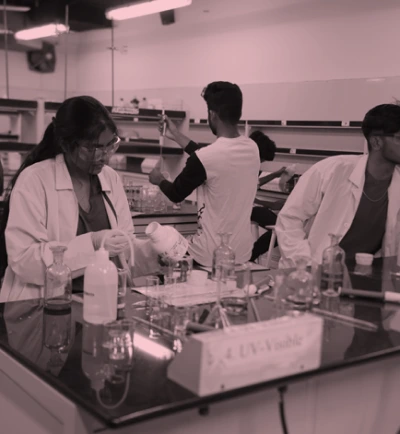
Varun Kumar
Assistant Professor
varun.kumar@mahindrauniversity.edu.in
Varun Kumar received his Ph.D. in Biotechnology from the Jaypee University of Information Technology, Himachal Pradesh. His doctorate research was carried out in a Programme support under ‘Centres of Excellence’ scheme of DBT, Gov. of India. Dr. Kumar’s research contributed to the elucidation of novel metabolic pathways for the biosynthesis of major phytochemicals in endangered Himalayan medicinal herbs. He is a recipient of ‘ARO postdoctoral fellowship’ of the Volcani Center, Israel, and the ‘Maria Zambrano postdoctoral fellowship’ of UPM, Spain. His postdoc research at ARO led to improved plants’ response to necrotrophic and insects’ pathogens. Dr. Kumar’s research revealed the mechanisms behind induced resistance in a variety of plant species including; chrysanthemum flowers and leaves of petunia, tomato and Arabidopsis. During his postdoc at CBGP, Spain, he investigated novel mechanisms of perception of plant cell-wall derived oligosaccharides and immune activation in Arabidopsis thaliana. His current lab interests are focused on engineering suitable hosts for production of high-value industrial phytochemicals, and the developing eco-friendly pest control strategies for controlling crop diseases.
2012 - 2017
- Ph.D. Biotechnology (2012-2017), Jaypee University of Information Technology, Solan, H.P., India
2008 - 2010
- M.Sc. Biotechnology (2008-2010), Kurukshetra University, Kurukshetra, Haryana, India
2005 - 2008
- B.Sc. Botany, Zoology, Chemistry (2005-2008), Kurukshetra University, Kurukshetra, Haryana, India
2022- Present
- 2022- Present Assistant Professor Center for Life Sciences Mahindra University.
2022 - 2018
- Maria Zambrano Postdoctoral Fellow (2022), Center for Plant Biotechnology and Genomics, Madrid, Spain
- Postdoctoral Fellow (2018-2022), Agricultural Research Organization, The Volcani Center, Israel
2017
- Senior Research Fellow-DBT COE Phase-II (2017), Jaypee University of Information Technology, Solan, H.P., India
2012 - 2015
- Senior Research Fellow-DBT COE Phase-I (2012-2015), Jaypee University of Information Technology, Solan, H.P., India
2012 - 2011
- Senior Research Fellow-ICAR (2011-2012), Division of Biochemistry, Indian Agricultural Research Institute, New Delhi, India
2011 - 2010
- Senior Research Fellow-ICAR (2010-2011), Department of Microbiology, CCS Haryana Agricultural University, Hisar, India
2022
- Wang R, Kumar V, Sikron-Persi N, Dynkin I, Weiss D, Perl A, Fait A and Oren-Shamir M (2022). Over a thousand-fold synergistic boost in viniferin levels by elicitation of Vitis vinifera cv. Gamay Red cell cultures over-accumulating phenylalanine. J. Agric. Food Chem. 70: 5049-5056.
2021
- Kumar V, Elazari Y, Ovadia, R, Bar E, Nissim-Levi A, Carmi N, Lewinsohn E and Oren-Shamir M (2021). Phenylalanine treatment generates scent in flowers by increased production of phenylpropanoid-benzenoid volatiles. Postharvest Biol. Technol. 181: 111657.
- Wang R, Lenka SK, Kumar V, Sikron-Persi N, Dynkin I, Weiss D, Perl A, Fait A and Oren-Shamir M (2021). A synchronized increase of stilbenes and flavonoids in metabolically engineered Vitis vinifera cv. Gamay Red cell culture. J. Agric. Food Chem. 69: 7922-7931.
- Wang R, Lenka SK, Kumar V, Gashu K, Sikron-Persi N, Dynkin I, Weiss D, Perl A, Fait A and Oren-Shamir M (2021). Metabolic engineering strategy enables a hundred-fold increase in viniferin levels in Vitis vinifera cv. Gamay red cell culture. J. Agric. Food Chem. 69: 3124-3133.
- Fang F, Oliva M, Ovadia R, Bar E, Nissim-Levi A, Kumar V, Wang R, Neeman A, Zaccai M, Lewinsohn E and Oren-Shamir M (2021). Increased substrate availability reveals the potential of scentless lisianthus flowers in producing fragrant benzenoid-phenylpropanoids. Physiol. Plant. 172: 19-28.
- Kumari A, Kumar V and Malhotra N (2021). Stevia rebaudiana. In: Malhotra N and Singh M (Eds.), Himalayan Medicinal Plants. Academic press, pp. 199-221.
2020
- Kumar V, Hatan E, Bar E, Davidovich-Rikanati R, Doron-Faigenboim A, Elad Y, Alkan N, Lewinsohn E, Spitzer-Rimon B and Oren-Shamir M (2020). Phenylalanine increases Chrysanthemum flower immunity against Botrytis cinerea attack. Plant J. 104: 226-240.
- Oliva M, Hatan E, Kumar V, Galsurker O, Nisim-Levi A, Ovadia R, Galili G, Lewinsohn E, Elad Y, Alkan N and Oren-Shamir M (2020). Increased phenylalanine levels in plant leaves reduces susceptibility to Botrytis cinerea. Plant. Sci. 290:110289.
2019
- Kumar A, Kumar V, Krishnan V, Hada A, Marathe A, Parameswaran C, Jolly M and Sachdev A (2019). Seed targeted RNAi-mediated silencing of GmMIPS1 limits phytate accumulation and improves mineral bioavailability in soybean. Sci. Rep. 9:7744.
- Kumar V (2019). OMICS-based approaches for elucidation of picrosides biosynthesis in Picrorhiza kurroa. In: Banerjee R, Kumar GV and Kumar SPJ (Eds.), OMICS-Based Approaches in Plant Biotechnology. Scrivener Publishing, pp. 145–166.
2017
- Kumar A, Kumar V, Krishnan V, Hada A, Marathe A, Parameswaran C, Jolly M and Sachdev A (2019). Seed targeted RNAi-mediated silencing of GmMIPS1 limits phytate accumulation and improves mineral bioavailability in soybean. Sci. Rep. 9:7744.
- Kumar V (2019). OMICS-based approaches for elucidation of picrosides biosynthesis in Picrorhiza kurroa. In: Banerjee R, Kumar GV and Kumar SPJ (Eds.), OMICS-Based Approaches in Plant Biotechnology. Scrivener Publishing, pp. 145–166.
2016
- Kumar V, Sharma N, Sood H and Chauhan RS (2016). Exogenous feeding of immediate precursors reveals synergistic effect on picroside-I biosynthesis in shoot cultures of Picrorhiza kurroa Royle ex Benth. Sci. Rep. 6:29750.
- Kumar V, Malhotra N, Pal T and Chauhan RS (2016). Molecular dissection of pathway components unravel atisine biosynthesis in a non-toxic Aconitum species, A. heterophyllum Wall. 3 Biotech 6(1):1-10.
- Sharma N, Kumar V, Chauhan RS and Sood H (2016). Modulation of Picroside-I Biosynthesis in Grown Elicited Shoots of Picrorhiza kurroa In Vitro. J. Plant Growth Regul. 35(4):965-973.
- Kumar V and Chauhan RS (2016). Higher amount of steviol detected in the leaves of a non-toxic endangered medicinal herb, Aconitum heterophyllum. J. Plant Biochem. Biotechnol. 25(4):442-445.
- Kumar V, Shitiz K, Chauhan RS, Sood H and Tandon C (2016). Tracking dynamics of enzyme activities and their gene expression in Picrorhiza kurroa with respect to picroside accumulation. J. Plant Biochem. Biotechnol. 25(2):125-132.
- Kumar P, Kumar V and Kumar GV (2016). Biosynthesis and pharmacological evaluation of shikonin-A highly valuable metabolite of North-Western Himalayas: Mini Review. Medicinal Plants - International Journal of Phytomedicines and Related Industries 8(4):267-274.
2015
- Kumar V, Sharma N, Shitiz K, Singh TR, Tandon C, Sood H and Chauhan RS (2015). An insight into conflux of metabolic traffic leading to picroside-I biosynthesis by tracking molecular time course changes in a medicinal herb, Picrorhiza kurroa. Plant Cell Tiss. Org. Cult. 123(2):435-441.
- Kumar V, Singh TR, Hada A, Jolly M, Ganapathi A and Sachdev A (2015). Probing Phosphorus Efficient Low Phytic Acid Content Soybean Genotypes with Phosphorus Starvation in Hydroponics Growth System. Appl. Biochem. Biotechnol. 177(3):689-99.
- Kumar V, Kumar V, Chauhan RS, Sood H and Tandon C (2015). Cost effective quantification of picrosides in Picrorhiza kurroa by employing response surface methodology using HPLC-UV. J. Plant Biochem. Biotechnol. 24(4):376-384.
- Kumar A, Kumar V, Lal SK, Jolly M and Sachdev A (2015). Influence of gamma rays and ethyl methane sulphonate (EMS) on the levels of phytic acid, raffinose family oligosaccharides and antioxidants in soybean seeds of different genotypes. J. Plant Biochem. Biotechnol. 24:204-209.
2014
- Kumar V, Kayasth M, Chaudhary V and Gera R (2014). Diversity of diazotrophs in arid and semi-arid regions of Haryana and evaluation of their plant growth promoting potential on Bt-cotton and pearl millet. Ann. Microbiol. 64(3):1301-1313.
- Kumar V and Gera R (2014). Isolation of a multi-trait plant growth promoting Brevundimonas sp. and its effect on the growth of Bt-cotton. 3 Biotech 4(1):97-101.
- Gera R, Kumar V and Shekhawat K (2014). Genotypic diversity of native population of rhizobia nodulating Vicia faba plants in arid and semi-arid regions of Haryana (India). Ann. Microbiol. 64(2):619-626.
- Kayasth M, Gera R, Dudeja SS, Sharma PK and Kumar V (2014). Studies on salinization in Haryana soils on free-living nitrogen-fixing bacterial populations and their activity. J. Basic Microbiol. 54(3):170-179.
- Kayasth M, Kumar V and Gera R (2014). Gordonia sp.: a salt tolerant bacterial inoculant for growth promotion of pearl millet under saline soil conditions. 3 Biotech 4(5):553-557.
- Gera R, Kumar V, Kayasth M, Walia M, Singh S and Goyal S (2014). Exploring the potential of phosphate solubilising diazotrophic Pseudomonas sp Db76 as plant growth promoter for Bt cotton. Journal of Cotton Research and Development 28(2):311-315.
- Gera R, Bhatia R, Kumar V, Kayasth M, Walia M, Kaur H and Goyal S (2014). Diversity and antibacterial activity of actinobacteria isolated from cotton fields in semi-arid zones of Haryana. Journal of Cotton Research and Development 28(1):129-134.
2013
- Kayasth M, Kumar V and Gera R (2013). Exploring the potential of PGPR strain Bacillus licheniformis to be developed as multifunctional Biofertilizer. Central European Journal of Experimental Biology 2(1):12-17.
2012
- Kuhar K, Kumar V, Kansal R and Gupta VK (2012). Isolation and in silico characterization of cDNA encoding cyclophilin from etiolated Vigna mungo seedlings. Braz. J. Plant Physiol. 24(1):69-73.
- Gera R, Bhatia R and Kumar V (2012). Comparison of nodC and 16S rDNA gene analysis of rhizobia associated with legumes of arid and semi-arid regions of Haryana. Journal of Food Legumes 25(4):294-299.
- Kayasth M, Kumar V and Gera R (2012). Isolation and identification of diazotrophic Bacillus subtilis strain SS2 from saline soil and its potential to be used as Biofertilizer. J. Microbiol. Biotech. Res. 2(5):772-777.
Our lab goal is intended to make innovative changes for development of ‘Superior’ and ‘Stronger’ plants.
1) Engineering suitable hosts for production of high-value industrial phytochemicals
Plants are a rich source for specialized metabolites serving in healthcare, nutritional and cosmetic industries. The supply of these metabolites is often obstructed due to the complexity of their tissue-specific production, existence of modified structures and lack of culture platforms and/or alternate production systems. These limitations pose challenges for industries in acquiring quality raw material with adequate amount of the target phytochemical. Our goal is to establish sustainable and superior production platform systems for specific phytochemicals of interest, by (a) Elucidation of biosynthetic routes for the production of target phytochemicals, and (b) Metabolic engineering either in the native host or in heterologous host for generation of superior systems.
2) Eco-friendly pest control strategy for economically important crops and ornamentals
Plants suffer from pests and diseases causing losses worldwide of up to 40% of crop yields. The protection of plants from pathogens is provided mainly by use of chemical pesticides, that eventually harm the environment and the health of farmers and consumers, and often result in development of resistant pathogen strains. Our lab is interested in understanding and exploring natural plant immune mechanisms to induce resistance against crop diseases by: (a) Identifying and over-producing specialized metabolites involved in the plant defense response; (b) Understanding plant defense signaling upon pathogen attack; and (c) Identifying potential active natural molecules and the mechanisms by which they protect plants.









